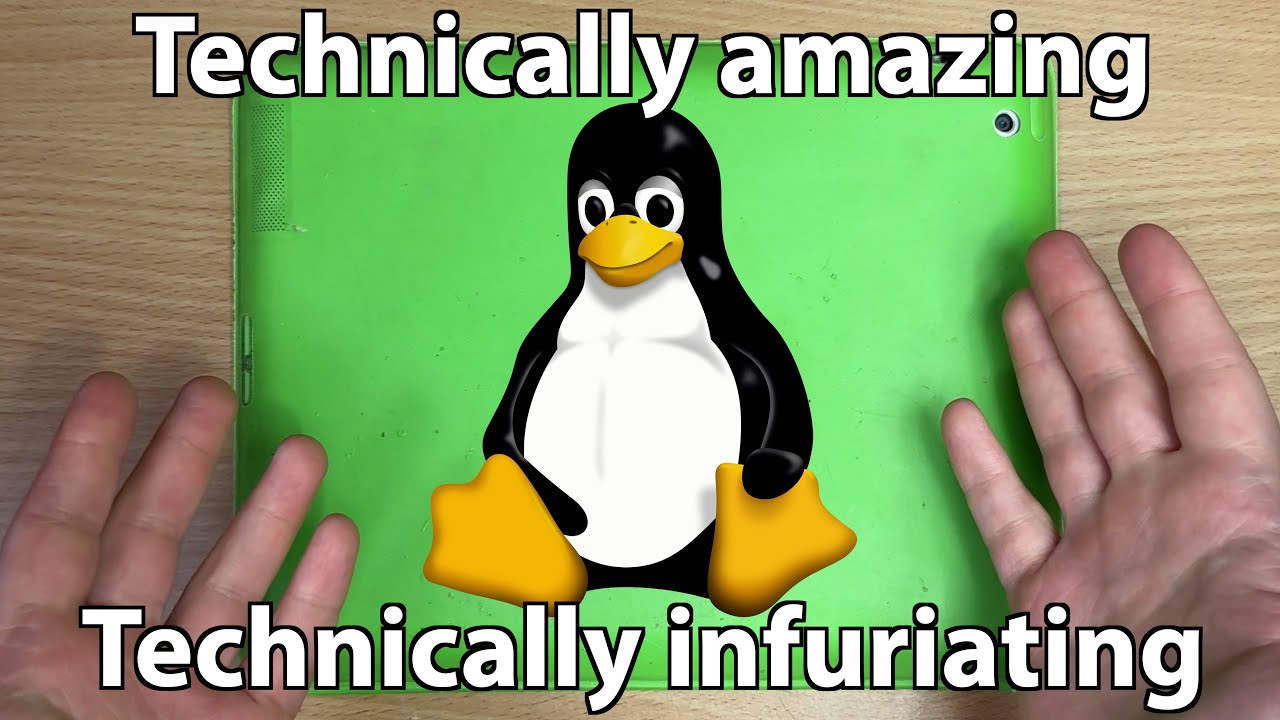cross-posted from: https://lemmy.ca/post/27756512
(Apologies if the link doesn’t work; Google are dicks)
Not sure who that is, but great 👍
I think the worst way to sum up his channel is that he reviews MP3 players and bad headphones. You’d really just have to see it, he’s very funny.
I think of him as a zillenial version of Ashens.
That is actually the best way of putting it.
Aussie Techmoan with Ashens for good measure.
How weird, I was just thinking about this guy yesterday after forgetting about him for probably ~5 years. I got pretty into buying, repairing, and modding broken iPods for a little while thanks in part to some of his goofy but informative teardown videos. Still have a small box of parts somewhere.
Haven’t watched the video yet, but I’ll be a little surprised if he doesn’t immediately fire up Shrek to test whatever media player came with his distro.
What exact GUI controls does linux lack that windows doesn’t?
He’s specifically using Ubuntu Gnome, which feels a lot less complete than even Linux Mint Cinnamon. Gnome doesn’t want you to customize it at all. I’m surprised they give you a master volume slider.
I used gnome though. IIRC, everything to do with customising GNOME is done through extensions, and all extensions have GUI settings menus.
My point being, even though it’s objectively harder to customise GNOME, it still doesn’t require using the terminal.
I mean, I hate Gnome and I think their work actively harms the Linux ecosystem. Gnome is deliberately unfinished. They have an artistic vision, and that artistic vision is blank uselessness is beautiful. They hate settings, they hate options. They get rid of as many settings and options as they can. Which means their UI feels incomplete to most people who try it for the first time coming from basically anything else. It’s so bad that third parties maintain “extensions” to add those options back in, and Gnome does everything they can to break those because their artistic vision does not include options. The ideal Gnome utility is a blank window with a button in the top bar that says “Never Mind.”
Many people trying Linux for the first time fail to find a setting in the options menu, conclude that Linux as a whole is dumb and bad and incapable because there’s no check box that puts the dock on the side or bottom of the monitor, you tell them to go install GnomeTweaks from the package manager, they point crotchward and say “Install this.” And they’re right, Gnome is unfinished and it’s not the end user’s job to finish it for them. Windows 95 had a robust system for changing the system theme, Gnome demanded we stop doing that.
I think you’re right in that most Gnome users don’t customize the GUI from the terminal, they install extensions. But if you ask a narrow question on a support forum, you’ll probably be told to run a terminal command, because that’s usually how Linux veterans communicate narrow answers to narrow questions over text-based media, and it’s also how a lot of system admin stuff like changing anything that ends up in /etc is done. I’ve never seen a GUI utility for editing fstab, everyone says to do that in the terminal. Gparted or Gnome-Disk-Utility might do it? I know KDE at least used to have the attitude that admin stuff should be done via the terminal. Dolphin and KATE didn’t have the option to Open As Root because they felt if you know enough to mess with the system directly you know enough to use the terminal to do so.
There are also just so many settings that just don’t reasonably have a GUI. Give you a personal example, I’m using an old speaker system that has a very hot external amplifier, every time the motherboard’s audio circuit would turn on or off the speakers would make a loud pop. I had to edit a couple files to change a 1 to a 0 and a Y to an N to stop that from happening. In Windows that would be a setting buried somewhere in Sound Settings > Volume > Advanced > More Options then the Power Saving tab or something, or maybe a registry key you’d use regedit to change. On Mint I could do it with Nemo and Xed, on some distros you have to use the terminal and something like Nano or Vim to change that setting. And newbies who probably didn’t choose their hardware for Linux compatibility and having to do workarounds to compensate are more likely to have to do stuff like that.
To be honest, a lot of system configuration is better done on the CLI or editing configuration files manually (see the majority of the audio stack). I like that approach way more than Windows but even the System Registry in Windows is more “GUI-like” than editing ALSA files or pam.d files manually (usually on the cli as they mostly require sudo). This scares people.
You want the most common things available in a Settings app(s) as they generally are on Gnome, KDE, Windows and Mac. If we cram too much stuff in there regular people struggle. Finding a good balance is a dilemma for most platforms. You want the less obvious stuff to be available in additional specialist “tweak” apps for more experienced users as they often are on all these platforms but sometimes less so on Linux. Then the really esoteric stuff you have to edit registry settings, conf files and plists as you do on all of them. Linux tends to provide more power and flexibility but requires reading documentation due to the diversity of config methods and locations.
A Mac user very sensibly contacted me worried about pasting a command to edit a plist into the terminal from a website they found trying to fix an issue. Nobody should be pasting commands they don’t understand into terminals. A quick search and I found the GUI toggle to do the same thing. It isn’t exclusively a Linux issue. Windows and Mac have complex operating systems underneath and equivalently powerful command line tools.
GUI config isn’t practical for hardcore linux users. It isn’t scriptable, we can’t store it in version control, it is harder to document, it is harder to use remotely. We have to appreciate that we have a growing number of users where it is worth taking a bit more time and sharing an alternative if one exists. However nobody wants to configure services in a GUI as we want to version, document and distribute this stuff and managing services in a GUI is unprofessional because you lose these things.
To be honest, a lot of system configuration is better done on the CLI or editing configuration files manually
and this is apparently a “problem”… people shy from the command line and fail to realize “we” continue to use it, not because there is no GUI alternative but because it is simply awesome!
¯\_(ツ)_/¯ , I can do every normal thing I wanna do in a GUI on Fedora
For what he said is more that when he search for something he only finds CLI commands, he just doesn’t know about the GUI controls.
'ol mate wade! he works on cars too on his channel ‘garbage time’
What is a dankpod?
He reviews/discusses mostly audio related tech (mainly headphones) but also dabbles in more generic mainstream tech like smartphones and laptops. The past few years he’s been expressing major frustration with the likes of Microsoft and Apple and I guess for the last few months has moved all his production over to Linux rigs, and even ditched his smart phone in favour of a modern flip phone.
Also he has a car channel called “garbage time” and a drumming stream called “garbage stream.” Very funny guy who’s definitely worth a watch.
I’ll check him out. Thx.
He also has a nugget cars channel where he reviews and tinkers with cheap old cars (and does things that outright would be qualified as torture if cars were sentient), also a music channel where he shows his drum playing and of course Frank’s channel, where he shows his pet snake, Frank. He calls it The Garbage Network.
“He”? I thought it was a brand of headphones lol
I didnt like very much his video. “You need the terminal to install vlc” wait what ? Ubuntu software library is here…
Also he says he will migrate to davinci resolve once he needs to, but oh boy I’ve been seeing a lot of videos about resolve on Linux and how painful it is to use (missing codecs, no pipewire support, hates Wayland …)
I’m not exactly the typical user here, but honestly Resolve is the best option on Linux. My caveat here is that I run Resolve on my stable box, which is a Debian box, and works beautifully.
codec support is the issue as a free version, but two things there - if you’re editing, mp4 is generally not what you want anyway, and you can just use ffmpeg (or any variety of tools that use ffmpeg underneath but give you a gui) if you’ve got a file you need that its the only container format.
If you’re doing it professionally, its $300, and worth buying. Much like buying Reaper for the whopping cost of $60 (personal)/$225 (commercial).
Regarding Wayland support, I think the first release addressing it was around March or April, and is fully supported in Resolve 19. I haven’t tested, because my Debian Stable box is not using Wayland, so I personally won’t test probably for a few months (or if I get an itch to try it on my 1700x Arch box).
GPU just needs OpenCL 1.2, so despite some previous snafus (needing nvidia) with GPU, AMD works just fine.
To be fair, the paid version of Davinci comes with the missing codecs. It’s only the free version that people have trouble with x264/x265.
Funny how he praises immutable Arch + KDE and then uses Ubuntu (Snaps, broken packages, themed GNOME, not immutable)
I hope he finds his way to Bazzite, Aurora or plain Kinoite, as this would suit him way better
I’d been meaning to try out atomic distros. I’m not an expert on Linux by any means but I’ve been using it on-and-off for about 25 years, and exclusively (at home, at least) for about 7. So I’m a bit more than a noob.
I do worry if I’d feel restricted inside of an atomic distro. Might throw kininite on a laptop I’ve been meaning to give to my kid, tho.
So…
Concept of OSTree or image-based
In theory “immutable distros” are safer to use. Not easier, but setting up stuff is less hard than fixing a system that doesnt boot or upgrade.
I am only focussing on Fedora Atomic desktops, which use OSTree (which is a version control system like git, but for binaries) and in the future/currently in parallel bootable OCI containers.
Both technologies have the same purpose, that your system is an exact bit-by-bit clone of the upstream system.
Layering
Now the system needs to have support for modding, doesnt it? Android doesnt, ChromeOS doesnt, I think SteamOS also doesnt? But this is Desktop Linux!
While many distros use flawed and incomplete concepts, lacking an “escape path” (reset) back to normal (100% upstream with no changes) (for example OpenSUSE microOS, VanillaOS etc), all such distros allow you to change the system.
The disadvantage of image-based is, that you always base of the unchanged image and then add your changes. On every update, you pull down the changes, open that thing up, throw in your changes, pack it again. This takes time and wouldnt be sustainable for example when using a phone.
So you kinda need custom images like uBlue. The advantage here is, that all changes are done on a single system and all clients just clone that. Fedora for exmample has notorious issues with an understaffed rpmfusion team and problems in coordination, so you might get sync issues and a critical security update doesnt work because of a random other package conflict.
or you might get a regression, uBlue could centrally roll that back.
Apps
Tbh the biggest issue is with edge cases of Flatpaks, like portals.
I just now needed to create a signature containing an image in thunderbird. The solution is to copy that image to the internal ~/.var/app/org.mozilla.thunderbird/ container and paste the exact file path there, as portals are broken after app restart.
Then adding an HTML as signature, it needs to be saved in the same folder and also linked exactly.
These edge cases are issues. Let alone missing hardware key support, no filesystem sandboxing in Firefox Flatpak (and uBlue and Fedora people think that is fine) or outdated target systems, because Flatpak needs to work on Debian 11 e.g.
There are also apps on Flathub that are broken, like QGis, or missing apps like RStudio, both known FOSS alternatives to stuff that people really use, and I couldnt even run those without Distrobox, which is also not preinstalled on Fedora Atomic Desktops, and toolbx lacks basic features like separated homedirs.
Yup, it is a rough field. But the stability is worth it. Also, official Flatpaks are great.
I’m thinking he might be happier with Noridian, ZephyrOS, Sylvanix, or AetherForge.
I myself have been trying neoNova, specTRAos, and VortexLinux and they’re all pretty good.
…
All of these are made up, I think, I just can’t cope with everybody and their dog still rolling their own distros (and alternatives to GNOME 3, thank goodness for KDE), even after 25 years of observing it happen over and over again.
They had us in the first half, not gonna lie
Those are not individual random 3rd party distros.
Please read up on that stuff first. I understand how oldschool users find this odd.
- Fedora is the base distro. Legally restricted, not being able to preinstall crucial components. They also do a bunch of annoying opinionated decisions, like Fedora Flatpaks or Toolbx instead of Distrobox.
- Fedora Kinoite: the immutable image of Fedora + KDE Plasma. Very barebones, not really user friendly out of the box, but a great distro. As an advanced user I use it daily.
- uBlue Bazzite and Aurora: take Fedora Atomic desktops, make them compatible with NVIDIA, ASUS, Surface and more. Add a ton of packages, many call that bloat, but it makes stuff work out of the box.
(Btw. great Distro names :D)
Those are so legit sounding I didn’t even realise until the second part of your comment those weren’t real.
Granted, I just slap kubuntu on everything because I’m used to managing ubuntu servers and like kde, so my distro knowledge is limited, but still
Poorly, Kubuntu uses the broken Plasma 5.27 for a while until the next release afaik.
Really that was kind of the plasma guys fault, but Plasma 6.0.2 or so was really stable. Perfect LTS candidate. Then the new features came in, now it is stable again (on Fedora).
I used Kubuntu and the outdated Plasma and many packages were annoying. Nowadays snaps, and removed base packages.
I looked into distros using plasma 6 for a bit, but decided it wasn’t worth the hassle. It’s also a not trivial boot setup (dual boot with w11 and bitlocker + LUKS + secureboot) and the (k)ubuntu installer just handled it flawlessly (meaning not having to enter my bitlocker key on every boot)
Works fine for me (except some weird locale issue, but I knew that in advance)
CentOS Stream 10 will likely use Plasma 6. That will be great.
They always add features and in Fedora it is a bit breaky breaky again. After a few minor updates its fine again, and just getting better.
Just the icons are missing I think, then it would be a great LTS.
Kubuntu uses Calamares, which is a nice installer. But I managed to wipe a drive once! Because by default it loses the destination drive selection, I went back to check if everything was fine and it selected my main drive again, I continued without noticing. woops!
What’s broken about it? I use Kubuntu and everything is working fine.
I used CentOS stream with Plasma 5 and there were a ton of bugs.
I myself reported over 200 plasma bugs and all recent ones were only fixed in 6. I am on Plasma 6 since half a year or so, so no idea what exactly that was, but a lot.
Also, Qt5 is EOL.
Ok, well “broken” sounded like, you know, that things don’t work.
Yup. They didnt, that is why I reported bugs.
https://bugs.kde.org/buglist.cgi?f1=reporter&list_id=2716961&o1=equals&resolution=---&v1=%25user%25
Not all made up though. I’ve been following this one’s mailing list for a while https://en.wikipedia.org/wiki/Zephyr_(operating_system)
I hopped a ton. Mint, Manjaro, MX Linux, Kubuntu, KDE Neon, Fedora KDE, Fedora Kinoite. Happy landing, and hopping was not fun, it simply was broken all the time.
What? No. He
- Wanted to configure stuff in a GUI (i.e. KDE, OpenSUSE with YaST does also a ton but often duplicated and distro-specific) and avoid needing the terminal for everything. GNOME is extreme here, as the settings are so restricted.
- Wanted to be restricted in the ability to break his system. This is extreme on SteamOS, but just as stable on other systems like Fedoras Atomic Desktops
Those were pretty much literally the things he said
Good point about immutability and his comment about not wanting to break his system, i forgot about that when writing. But I disagree about Arch, snaps, those are technical details. Not sure which broken packages you’re talking about or why him using modified Gnome matters.
The Universal Blue distros are cool though, though I’ve only briefly used their lightly modified main image.
GNOME has very little settings.
I actually gave Fedora Silverblue a try, documented here. This was not beginner friendly at all and still lacked many features in the end.
So this is the issue when GNOME doesnt allow basic things, like editing desktop files in a guided way, showing package names etc.
Ubuntu has had broken packages for a lot of 3rd party software (when I last used it, a few years ago), for example SciDAVis which I used, and Libreoffice and more. Flatpak works without issues here. Beginners will not add Flatpak and have issues here.
I didnt say anything about Arch I think. He also doesnt care about that. Using Arch as base really just makes sense for Valve, as it is neutral, not legally restricted etc.
uBlue deals with the constant sync (and coordination) issues between Fedora and rpmfusion. When using Arch, this is not needed.
Some of my fav quotes:
“Ads in an operating system that you’ve paid for from a company that owns ridiculous amounts of money is so offensive.”
“data, it’s like the new gold to people”
“I got the confidence to really jump into Linux after the Steam Deck.”
[regarding the terminal] “You just see text going across the screen, they’re working at lightning speeds.”
“I’m kissing convenience goodbye, I just want control.”
“I’m kissing convenience goodbye, I just want control."
He is in for a surprise when he realizes GNU/Linux is much more convenient than Winblows.
It’s as complicated as you make it to be, and that’s gonna vary WILDLY per person lmao
Everything is complicated if you aren’t willing to commit/learn.
If you learn how to do a complicated thing, it’s still complicated.
Arguable
Niche software like the Microsoft suite? It all depends on the environment you use it in I think
HAHAHAHHAHA
where can I get a NixOS Flare?
I don’t think it’s really much different. What makes windows feel more convenient is that everyone generally learns how to use it first. I think if you took a person that is not familiar with either, they would be able to figure out both OS at around the same time.
at this point i have utterly forgotten how windows works and when placed in front of a computer not running linux i just get frustrated that it won’t let me do things properly
LET ME OPEN A TERMINAL AND USE REGULAR COMMANDS YOU OVERBUILT TOASTER
it really just depends on what hardware you are on. For example my Dell pribter was plug and play on windows . It took me 6 hours to get it to work on Linux.
I had a printer I could not in my life make work on a Windows PC (2017). Then I tried my Ubuntu laptop, no drivers installed, just worked.
Fuck Windows.
This. In my recent experience on one laptop. Arch (Endevour OS btw) installed fine.
But LMDE would not boot. I got a system disk missing error every time after install. So much playing with EUFI settings in BIOS, boot back to live disl, multiple re installs, GRUB repair, remake the ISO (ISO was fine, installed on another PC with no issues). Gave up. Just could not boot to the OS.
Install normal mint. No issues.
And past the install? Bluetooth dongle works fine on arch, but so many issues on mint.
WiFi dongle A works on arch, but not mint. WiFI dongle B dosenr work on arch but does work on mint. Took me a while to work thst one out.
Headphpnes have some weird echo back to me when mic is on. Use pipewire config from archwiki. Worked, but reduced qualoty. Tried a few other configs. Didn’t work. Must have broke something coz now the original config dosnt work. So will just deal with echo.
0 of these issues on windows. And 0 likely your regular user can easily swap to Linux.
Will stay on arch tho. Fuck
spezwindows.I just installed endeavor an hour ago. I switched from kubuntu. I love the style of the is and arch programs seem to work better out of the box compared to Debian.
Maybe it’s just me, I always had issues with Ubuntu and Debian based distros that I didn’t have with Arch based distros. Why do people say Arch is harder? That was never my experience. I’ve been using endeavorOS and it’s been pretty great.
Arch does tend to keep packages as close to upstream as possible, which can be both a good and bad thing. Sway not binding to
graphical-session.targetby default is a little strange for example. Other distros also save a first-time user a great deal of configuration for things they probably don’t care about as well. Going through Fedora’s install and finding out that disk encryption and SELinux were configured OOTB was very nice to see personally. On the other hand Arch’s installation (w/o archinstall) has you choosing a bootloader, audio server, display manager, etc. Nothing arduous and I like it, but definitely not for everyoneThis is all eliminated by spinoffs of course, but even there users have the option to run random scripts/AUR packages without vetting them. Also doesn’t help that the most popular Arch-based distro for a while (Manjaro) was pretty flaky and generally incompatible with the AUR (despite saying otherwise), leading to many people saying “that’s just Arch” and swearing off the parent project as well
For me it’s the wiki. Arch just explaining so simply. Searching an issue for LMDE just lead to forums. And the Debian or Ubuntu wikis don’t seem as good as arch.
Plus must searches for <other distro> issue seem to lead to forums and random “run this code”. All arch searches led back to the Wiki. All hail the wiki.
But srsly. I feel like I’m LEARNING Linux with arch. Rather than just running fixes for the other distros.
It really comes down to if you are trying to use newer hardware or not. Debian based systems usually run fine out of the box on older systems.
For newer hardware your going to want new drivers and kernel versions which you get with a rolling release distro.
True, meanwhile my HP printer had a hell of a time trying to work on windows much less finding an actual downlosd for the scanner tool on HP’s websitr for a printer ovrr 5 years old and on Linux I typed
yay HP,1, then I was ready to print and scan.Plus KDE discover is the convenience if the Microsoft store was actually good.
Settings are ACTUALLY in setting instead of being split between settings, control panel, individual tool auto diagnoses, powershell, and registry edits.
KDEconnect works seamlessly and I can also locate my phone if I lost it in the house.
Yep, it really just comes down to complete luck that there are drivers in the kernel for your hardware. As another example, my Lenovo Legion sucks at running Linux out of the box. The webcam is terrible, it never suspends correctly, outputting to a monitor is incredibly painful. Meanwhile my wife’s thinkpad runs popos perfectly. Even the touchscreen works.
Assuming you don’t need a windows only application for your workflow (admittedly this isn’t very common), it’s really just a matter of getting used to it. There’s plenty of easy to use distros out there, such as Linux “I’m not buying my grandma a new computer” Mint.
Precisely… which means switching to Linux is not inherently less convenient than windows
“I got the confidence to really jump into Linux after the Steam Deck.”
I offered my son (16) to get him an “office” computer for his room so he can do homework and emails and junk. He said he felt so comfortable with Linux because of the Steam Deck and we could instead just get a nicer monitor and a docking station and he will use the Deck as a gaming machine AND office workstation whenever our main computer (also Linux) is busy
I think it should be really clear to everyone now that the Steam Deck is exactly the kind of thing that Linux needs: nice hardware with a well-integrated OS that is designed to be user-friendly and has some guardrails to prevent you from breaking it.
the Steam Deck effect.
M’butu
I never heard of this project before but I just looked it up and it looks like it’s about vintage MP3 player upgrading? Anyways nice to see more people, especially ones with niche jobs like this one, switching. Linux is slowly becoming a pretty major thing.
It is actually just an aussie looking at weird audio stuff. He started off with upgrading old Ipods but now he just does whatever he wants.
I like his other channels for drums / drum history (Drum Thing) and cars (Garbage Time), but notably the main DankPods channel has 1.65 million subs which could bring a load of new people’s attention to Linux.
I just checked his video about switching to Linux and I’d say it’s going to scare most potential users away more than attract them. His use case is extremely specific and even kinda creepy for a not savvy person.
Creepy???
I agree he didn’t do a good job evangelizing Linux. He made a video about his experiences with it, but I do think it’s representative of someone googling and first time trying Linux on their own without a guide friend to tell them, “oh you can do it this way now.” Him ultimately sticking with it in spite of that for data sovereignty is kind of the whole point of Free Software so I can respect that.
onya m8
@hellfire103 I switched over a few months back to avoid all the new M$ bullshit.
No regrets.
‘I’m turning into a penguin’
Good onya mate!






























